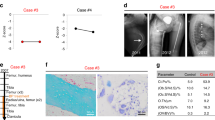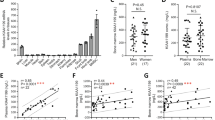Abstract
Gene therapy for dominant-negative disorders presents a more difficult challenge than gene therapy for recessive disorders, since even partial replacement of a protein for a recessive disorder can reverse symptoms. Osteogenesis imperfecta (OI) has frequently served as a model disorder for dominant-negative defects of structural proteins. The disease is caused by mutations in type I collagen (COL1A1), the major structural component of bone, skin and other connective tissues. The severity of the phenotype is largely dependent on the ratio of normal to mutant type I procollagen synthesized by cells. Recently, attempts have been made to develop strategies for cell and gene therapies using the adult stem cells from bone marrow referred to as mesenchymal stem cells or marrow stromal cells (MSCs). In this study, we used MSCs from a patient with type III OI who was heterozygous for an IVS 41A + 4C mutation in COL1A1. A hybrid genomic / cDNA construct of COL1A1 was transfected into the MSCs and the transfectants were expanded over a 200-fold. Transfected MSCs showed increased expression of the wild-type mRNA and protein. In vitro assays demonstrated that the transfected cells more efficiently differentiated into mineralizing cells. The results indicated that it is possible to overexpress COL1A1 cDNA in OI MSCs and thereby to correct partially the dominant-negative protein defect.
This is a preview of subscription content, access via your institution
Access options
Subscribe to this journal
Receive 12 print issues and online access
$259.00 per year
only $21.58 per issue
Buy this article
- Purchase on Springer Link
- Instant access to full article PDF
Prices may be subject to local taxes which are calculated during checkout





Similar content being viewed by others
References
Kuivaniemi H, Tromp G, Prockop DJ . Mutations in fibrillar collagens (types I, II, III, and XI), fibril-associated collagen (type IX), and network-forming collagen (type X) cause a spectrum of diseases of bone, cartilage, and blood vessels. Hum Mutat 1997; 9: 300–315.
Myllyharju J, Kivirikko KI . Collagens and collagen-related diseases. Ann Med 2001; 33: 7–21.
Pereira RF et al. Marrow stromal cells as a source of progenitor cells for nonhematopoietic tissues in transgenic mice with a phenotype of osteogenesis imperfecta. Proc Natl Acad Sci USA 1998; 95: 1142–1147.
Horwitz EM et al. Clinical responses to bone marrow transplantation in children with severe osteogenesis imperfecta. Blood 2001; 97: 1227–1231.
Horwitz EM et al. Transplantability and therapeutic effects of bone marrow-derived mesenchymal cells in children with osteogenesis imperfecta. Nat Med 1999; 5: 309–313.
Horwitz EM et al. Isolated allogeneic bone marrow-derived mesenchymal cells engraft and stimulate growth in children with osteogenesis imperfecta: implications for cell therapy of bone. Proc Natl Acad Sci USA 2002; 99: 8932–8937.
Koc ON et al. Allogeneic mesenchymal stem cell infusion for treatment of metachromatic leukodystrophy (MLD) and Hurler syndrome (MPS-IH). Bone Marrow Transplant 2002; 30: 215–222.
Koc ON et al. Randomized cross-over trial of progenitor-cell mobilization: high-dose cyclophosphamide plus granulocyte colony-stimulating factor (G-CSF) versus granulocyte–macrophage colony-stimulating factor plus G-CSF. J Clin Oncol 2000; 18: 1824–1830.
Cabral WA et al. Procollagen with skipping of alpha 1(I) exon 41 has lower binding affinity for alpha1(I) C-telopeptide, impaired in vitro fibrillogenesis, and altered fibril morphology. J Biol Chem 2002; 277: 4215–4222.
Hormuzdi SG, Penttinen R, Jaenisch R, Bornstein P . A gene-targeting approach identifies a function for the first intron in expression of the alpha1(I) collagen gene. Mol Cell Biol 1998; 18: 3368–3375.
Krempen K et al. Far upstream regulatory elements enhance position-independent and uterus-specific expression of the murine alpha1(I) collagen promoter in transgenic mice. Gene Expr 1999; 8: 151–163.
Braut A et al. COL1A1-GFP transgene expression in developing incisors. Connect Tissue Res 2002; 43: 216–219.
Hernandez I et al. Collagen alpha1(I) gene contains an element responsive to tumor necrosis factor-alpha located in the 5′ untranslated region of its first exon. DNA Cell Biol 2000; 19: 341–352.
Olsen AS, Geddis AE, Prockop DJ . High levels of expression of a minigene version of the human pro alpha1(I) collagen gene in stably transfected mouse fibroblasts. Effects of deleting putative regulatory sequences in the first intron. J Biol Chem 1991; 266: 1117–1121.
Sarafova AP et al. Three novel type I collagen mutations in osteogenesis imperfecta typy IV probands are associated with discrepancies between electrophorectic migration of osteoblast and fibroblast collagen. Hum Mutat 1998; 11: 395–403.
Prockop DJ, Gregory CA, Spees JL . One strategy for cell and gene therapy: harnessing the power of adult stem cells to repair tissues. Proc Natl Acad Sci USA 2003; 100 (Suppl 1): 11917–11923.
Sokolov BP et al. Tissue-specific expression of the gene for type I procollagen (COL1A1) in transgenic mice. Only 476 base pairs of the promoter are required if collagen genes are used as reporters. J Biol Chem 1995; 270: 9622–9629.
Constantinou-Deltas CD, Ladda RL, Prockop DJ . Somatic cell mosaicism: another source of phenotypic heterogeneity in nuclear families with osteogenesis imperfecta. Am J Med Genet 1993; 45: 246–251.
Cabral WA, Marini JC . High proportion of mutant osteoblasts is compatible with normal skeletal function in mosaic carriers of osteogenesis imperfecta. Am J Hum Genet 2004; 74: 752–760.
Forlino A, Marini JC . Osteogensis imperfecta: prospects for molecular therapeutics. Mol Genet Metab 2000; 71: 225–329.
Millington-Ward S et al. RNAi of COL1A1 in mesenchymal progenitor cells. Eur J Hum Genet 2004; 12: 864–866.
Chamberlain JR et al. Gene targeting in stem cells from individuals with osteogenesis imperfecta. Science 2004; 303: 1198–1201.
Stanford CM et al. Rapidly forming apatite mineral in an osteoblastic cell line (UMR 106-01 BSP). J Biol Chem 1995; 270: 9420–9428.
Hojima Y, van der Rest M, Prockop DJ . Type I procollagen carboxyl-terminal proteinase from chick embryos. Purification and characterization. J Biol Chem 1985; 260: 15996–16003.
Acknowledgements
The work was supported in part by grants from NIH (AR-48323), HCA the Healthcare Company, the Oberkotter Foundation, and the Louisiana Gene Therapy Research Consortium to DJP and NIH / NIAMS fellowship to RRP.
Author information
Authors and Affiliations
Rights and permissions
About this article
Cite this article
Pochampally, R., Horwitz, E., DiGirolamo, C. et al. Correction of a mineralization defect by overexpression of a wild-type cDNA for COL1A1 in marrow stromal cells (MSCs) from a patient with osteogenesis imperfecta: a strategy for rescuing mutations that produce dominant-negative protein defects. Gene Ther 12, 1119–1125 (2005). https://doi.org/10.1038/sj.gt.3302514
Received:
Accepted:
Published:
Issue Date:
DOI: https://doi.org/10.1038/sj.gt.3302514
Keywords
This article is cited by
-
Ponicidin Treatment Improved the Cell Proliferation, Differentiation, and Calcium Mineralization on the Osteoblast-Like MG-63 Cells
Applied Biochemistry and Biotechnology (2022)
-
A recombinant adenoviral vector with a specific tropism to CD4-positive cells: a new tool for HIV-1 inhibition
Drug Delivery and Translational Research (2022)
-
Augmenting and directing long-range CRISPR-mediated activation in human cells
Nature Methods (2021)
-
Effects of ginsenosides on bone remodelling for novel drug applications: a review
Chinese Medicine (2020)
-
Whole genome sequence analysis reveals genetic structure and X-chromosome haplotype structure in indigenous Chinese pigs
Scientific Reports (2020)



